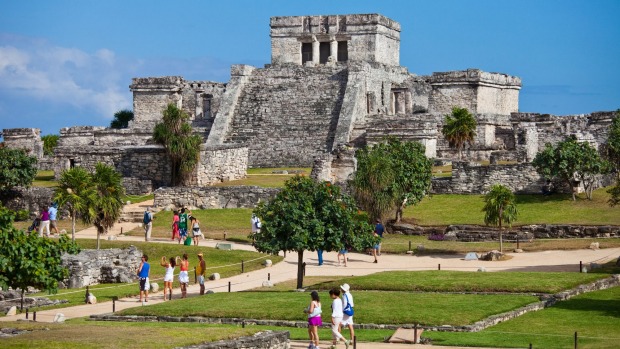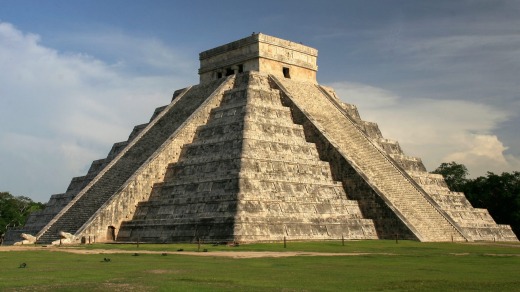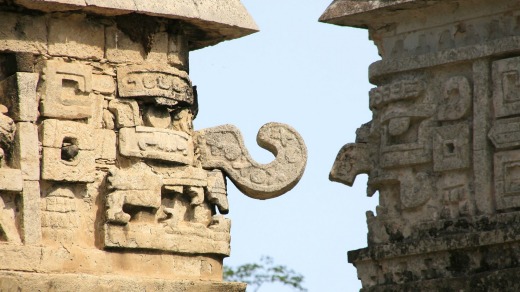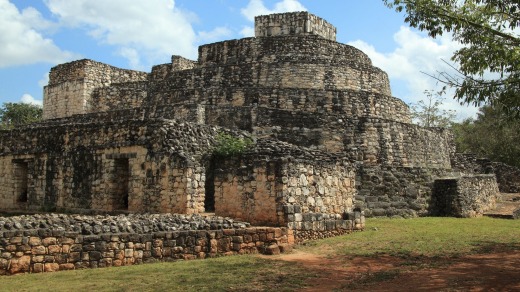
The ropes are there to keep the humans out, but the iguanas have no intention of paying attention to them. They roam the ancient Mayan city of Tulum with impunity, scuttling up the steps if they wish, but mainly lying out on the grass to catch the sun.
Tulum is a beginners' Mayan ruins, handily positioned on the Riviera Maya coastal resort strip. But it has always been the introduction to the Mayan world – it was the first city the Spanish saw when sailing past in 1518.
Many of the key features that can be found in other Mayan cities can be found at Tulum. The stone-built main area was reserved for the ruling and priestly classes, while ordinary folk lived outside the walls. Entrance is through a false arch, which uses a capstone rather than a keystone, and the steep-stepped edges of the arch mirror those of the key temples.

If the walls were too far apart, the whole structure would collapse. So rooms, even for the kings, were surprisingly narrow. And to build upwards, previous temples had to be filled in to act as supports for the new, grander efforts built around and above.
By Mayan standards, the buildings at Tulum are modest, a sure sign that they were built in around 1200AD. This was in the post-classic period when the civilisation's great cities had collapsed and smaller, fragmented settlements became the norm.
Tulum is, however, the only Mayan city on the coast. Boats carrying jade, obsidian and other precious materials would pull up on the white sand beach after passing through the second longest barrier reef in the world.

That's when you learn how the ancient Mayans' extraordinary design and mathematical skills hit home. The gap in the reef lines up with the main temple. If, from the sea, you could see directly through the main window, you knew you were in the right place.
Mexico's Yucatan Peninsula is liberally dotted with Mayan sites, many with something extraordinary to mark them out. Coba wins on height of towers, Uxmal on level of decoration and Calakmul on power of the state that once called it capital.
But for sheer bulk, it's tricky to look past Ek Balam. Most of the site is still under jungle – the hillocks are actually unexcavated buildings – but the Acropolis is mostly cleared and absolutely enormous. At 160 metres long, 70 wide and 31 high, it's a classic example of building on top of previous structures.

When excavating, archaeologists found an almost perfectly preserved chamber shaped like a monster's mouth, complete with teeth.
Glyphs carved nearby revealed the body found in there to be the one-time king – and it is thought that his son had the tomb covered and sealed to protect it from enemies who'd break in and scatter the bones.
More to the point, this is one of the few major Mayan structures that isn't roped off. The steep, sweaty climb up takes you above the treeline – and the horizon is just green with the odd temple top peeking out.
Everything's much clearer, however, at the most famous Mayan site (with heavy Toltec influence). Chichen Itza's grandest buildings stand on a cleared lawn. El Castillo – the one from all the photographs – is the crowning glory, full of hidden tricks and meanings.
During the autumn and spring equinoxes, the light makes a snake shape down the edge of the grand pyramid, while the 91 steps on each side, plus the one on top, add up to 365, representing the days of the year.
Clap outside the pyramid, and the acoustics make for a squawk-like sound – designed to be similar to the call of the quetzal bird that was so admired for its feathers.
There's also the huge ball-game court, 96m long, with the hoops the players had to hit the ball through still intact. Nobody quite knows what the rules are – Spanish interpretations came from seeing the Aztec version of the game, but that could have been as different as Australian Rules Football is to global football.
There are theories that winning or losing captains may have been sacrificed afterwards, but as with so many aspects of the ancient Mayans, they are just that: theories.
And as for the theories why the great civilisation collapsed, guide Abel Parilla has one. "To build this, they had to clear so much forest," he says outside El Castillo. "And the deforestation changed weather patterns. So when the priest predicted rain and it didn't come, the people lost faith and the priests lost control."
It's as good a guess as any. But it's not a bad place to stand staring in wonder at the possibilities.
www.inah.gob.mx has details of the major Mayan sites, including opening times and entry fees.
United flies to Cancun via Los Angeles and Houston from Sydney and Melbourne. See www.united.com
In Tulum, the laid-back beachfront El Paraiso Hotel is about 800 metres from the ruins, with rooms from $A170 see elparaisohoteltulum.com. In Valladolid, close to Ek Balam and Chichen Itza, the atmospherically colonial El Meson del Marques has rooms from $A54 . See www.mesondelmarques.com.
Self-driving gets you to the ruins before the tour buses arrive. International firms such as Alamo, Europcar and Avis have outlets at Cancun airport.
Swim with whale sharks: They make an appearance off the north-east coast between June and September. Cancun Adventures takes visitors out there with snorkels. See www.cancun-adventure.com.
Go flamingo-spotting: The massive Ría Lagartos estuary is a haven for the gorgeous pink birds. Boat trips through the mangroves will take you out to see them. See www.riolagartosnaturetours.com.
Dive in cenotes (sinkholes): Sinkholes all over the peninsula are the gateway to an underground river system. Many are open for swimming, but more adventurous explorers can take on diving expeditions. The Akumal Dive Shop runs tours. See www.akumaldiveshop.com.
Get gum: Discover how chewing gum is harvested from trees at a traditional camp in the Sian Ka'an Biosphere Reserve. See www.siankaantours.org.
Go colonial: The cities of Valladolid and Merida have plenty of gorgeous Spanish colonial buildings, but the Hacienda Yaxcopoil is an impressive and faithfully maintained example of the peninsula's wealthy European-era estates. See www.yaxcopoil.com.